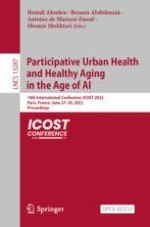1 Introduction
2 Related Work
3 Technologies and Architecture of the Virtual Coach
3.1 Multimodal Data Fusion from Sensors
3.2 Emotion Detection System
3.3 Knowledge Graphs
3.4 Dialogue System
4 Prototype Virtual Coach
4.1 Requirements Gathering and Analysis
-
Tell that you feel sad – the user expresses sad emotions and the coach aims to provide empathic and consoling companionship.
-
Tell that you want some exercise – the user tells the coach that he/she wants some exercise. The coach records the user’s exercise preferences and provides options that can help improve the user’s health and physical condition.
4.2 Interactions with the Prototype Dialogue System
-
Daily support;
-
Health activity support;
-
Environmental monitoring support;
-
Question-Answering over Wikipedia, News;
-
Social Activity support.
- story: preventive examinations, the male user would like to know what preventive measures he can receive | |
steps: | |
- | intent: ask_examinations |
- | slot_was_set: |
- | user_gender: null |
- | action: utter_ask_gender |
- | intent: say_gender |
- | action: action_examination_KG #KG data |
- | action: utter_suggest_examination |
